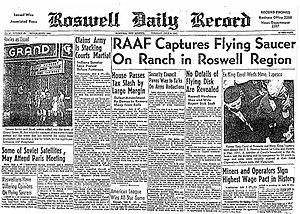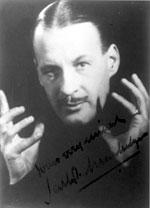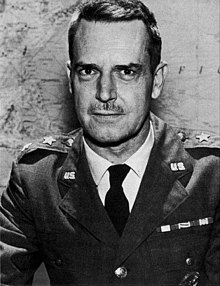The
topic of Jeff Ritzmann's latest Paranormal Waypoint was alleged UFO cover up. The show aired on KGRA Radio the evening of
Tuesday, June 24. I found listening and following along in the chat
room to be time well spent.
As
the episode came to a close, Ritzmann suggested he finds the
topic quite interesting and could discuss it for hours. I can relate
to that, and would therefore like to write some about it.
Buzz
Killer of a Topic
For
one thing, I particularly appreciated Ritzmann's willingness to
address at length the complexities of UFOs as they relate to spy games, deception operations and disinformation.
Important phrase here, please: This is typically not an activity that
garners much support. As a matter of fact, careful and accurate
examination of government UFO-related sleight of hand is
entirely likely to substantially decrease one's popularity within the
UFO community.
There
are several reasons that is the case. All of those reasons pretty
much boil down to the same thing, though: Supporters of the ETH –
or even those who tend to see UFOs as indicative of some kind of yet
to be understood high strangeness – become insecure. If we can get past that and understand there are many extremely interesting aspects of ufology that do not necessarily have anything to do with the experiences and perceptions of anyone in particular, we liberate ourselves to embark on some very intriguing subject matter.
You know how it goes, though. Reporting on hoaxes and professional photo
analysis just are not crowd pleasers. It's very similar with
considerations of spooks in ufology in that if you suggest the G-Men
are hanging around for any other reasons than to hide and explore an
alien presence, or at the least a mysterious phenomenon, you're often encouraged to pack up your research and
take it down the road. I therefore appreciated Ritzmann's careful and measured approach to the topic.
Why
so Much Official Interest in Ufology if There's No Cover Up?
As
Ritzmann explained, there are actually many reasons the
intelligence community might take an interest in manipulating
circumstances and reports surrounding public perception of UFOs.
Those reasons include but are by no means limited to:
- Leading
global adversaries to fear extraordinary "UFOs" are actually
advanced exotic US aircraft and weapons of which they are
defenseless.
- Leading
adversaries to fear UFOs may actually be alien spacecraft, of which any number of concerns should arise, including US officials have reverse engineered aspects of the craft and/or collaborated with the
occupants to receive access to advanced technology.
- Leading
adversaries to frustratingly conclude they
have become confused about UFOs to the point of accepting they have virtually no
idea what is flying around, who flies it or what its capabilities may
be (not entirely unlike many members of the UFO community).
- Meme creation and tracking, which have been repeatedly demonstrated by agencies such as the USAF and DARPA to be prioritized and valued for psychological warfare reasons
ranging from spreading dissent to manipulating superstitions.
- The use of public perception of the UFO phenomenon as cover for classified operations that have nothing to do with unexplained aerial phenomena, extraterrestrial life or anything of the kind.
- The use of public perception of the UFO phenomenon as cover for classified operations that have nothing to do with unexplained aerial phenomena, extraterrestrial life or anything of the kind.
Many
more reasons could be listed with citations of confirmed examples.
It's not just hypothetical by any means, but documented Cold War
history.
Further complicating the already complex circumstances is the popular yet unsubstantiated suspicion of an all-knowing, ultra secret governmental body that scrupulously conceals the answers to all our questions. There is almost
certainly no small group of select individuals or single person aware of details about everything of ufological interest ranging from Roswell
to Rendelsham. Neither is there a lone reason employed for some 70 years as to why the intelligence community manipulates various circumstances that we, in UFO circles, typically interpret to be related to ufology. There are lots of different reasons. Specific purposes change from one circumstance to the next.
There is no single reason Uncle Sam - and his evolving personnel from one era to the next - would go to so much trouble; it
involved matters of opportunity, necessity and feasibility from any given situation to another.
To
many a UFO enthusiast the issues of interest become if the powers that be have any direct
knowledge of the actual nature of UFOs and if they are intentionally
covering it up. As Ritzmann aptly pointed out, that is going to be difficult to conclusively answer for a lot of reasons. One
of the biggest challenges is that learning more is no longer a matter of getting just Uncle Sam to open his archives - and difficult as that may
have been. Those days are gone and it's now even more complicated.
The
Other CIAs
Controversial
philanthropist Robert Bigelow has been flip flopping between acting as a
funding source and pulling the rug out from under ufologists for
decades. If he has obtained any information of particular relevance,
many would argue we'd sooner get the NSA to lay their cards on the table – and
assuming, of course, they're not virtually one and the same. In preparation for a previous post, I asked Col. John Alexander a few questions about his interpretations of some situations in which he was involved with Bigelow at the time, including the Carpenter Affair and if the colonel was at liberty to discuss relationships between Bigelow corporations and intelligence agencies.
"You should ask Bigelow if you are interested in old affairs," Alexander replied.
"You should ask Bigelow if you are interested in old affairs," Alexander replied.
Private
citizens and private corporations, under no obligations to the
Freedom of Information Act and conducting what amount to intelligence
operations, may pose some of the greatest challenges of all to
researchers' abilities to document actuality. The difficulties are in
all likelihood an intentional outcome whether or not the UFO mystery
may have played a minor role in their design.
 |
| A former BAH contractor you may have heard of |
You're
not going to be getting access to BAH's files. Not now, not in the foreseeable future and probably not ever. There will be no declassification process,
and BAH is but one corporation of many providing Uncle Sam with
options for intelligence outsourcing; options that some liken to
non-governmental CIAs. Those would be, in effect, intelligence
agencies never subjected to Congressional oversight.
Mirage
Men
I'm
not trying to tell you there are no UFOs – and neither did
Ritzmann. But I am most certainly trying to tell you to at least
suspend judgment pending verifiable information before you draw
conclusions about what roles the intelligence community may have played in
the apparent UFO mystery.
Another
point of interest for me on Paranormal Waypoint Tuesday was a
situation described by Ritzmann relating to the complexities of
trying to reason our way through subject matter so often involving
deception. He explained a circumstance about witnesses who
apparently did not know each other and resided far apart, yet
offered similar testimony. Ritzmann questioned whether or not
such a situation might be as credible as it initially appears, considering the resources available to
professional architects of deception. Ritzmann particularly questioned the decision-making process of researchers who choose to accept such witness testimony as accurate and subsequently promote it.
I
happen to currently be reading The Rosetta Deception by James Carrion. While any number of circumstances could be cited
involving procedures to intentionally cultivate rumors and spread
propaganda that would justify Ritzmann's concerns, I will call on
Carrion since his work happens to currently be sitting on my desk.
 |
| Head of the covert BSC William Stephenson, credited with changing American public perception of issues related to World War II |
The
skilled and effective BSC also noted that a good rumor should never
be traceable to its source. Please be advised that there is indeed no substitute for actually confirming a claim. Verifiable evidence available for public review is virtually the only circumstance that justifies anything more than suspension of judgment in such situations.
I'd
like to leave you with one more consideration, please. I
was recently reviewing rather fascinating circumstances described in
a now declassified CIA report written by Edward F. Deshere and
titled, Hypnosis in Interrogation.
Deshere described
the deviously deceptive work of MKULTRA Subproject 84 lead
researcher Dr. Martin Orne and his "magic room":
A captive's anxiety could be heightened, for example, by rumors that the interrogator possesses semi-magical techniques of extracting information. A group of collaborating captives could verify that interrogees lose all control over their actions, and so on. After such preliminary conditioning, a "trance" could be induced with drugs in a setting described by Orne as the "magic room," where a number of devices would be used to convince the subject that he is responding to suggestions. For instance, a concealed diathermy machine could warm up his hand just as he receives the suggestion that his hand is growing warmer. Or it might be suggested to him that when he wakes up a cigarette will taste bitter, it having been arranged that any cigarettes available to him would indeed have a slight but noticeably bitter taste. With ingenuity a large variety of suggestions can be made to come true by means unknown to the subject. Occasionally these manipulations would probably elicit some form of trance phenomenon, but the crucial thing would be the situation, not the incidental hypnotic state. The individual could legitimately renounce responsibility for divulging information much as if he had done it in delirium.
Perhaps
Deshere is giving us a glimpse into one of the most intriguing
aspects of all of the Mirage Men's elusive tricks: They did not have to perfect the brainchildren born in the labs of mad scientists – or necessarily even get the ideas to work at all – as much as lead the world to believe so. A preferred mind control
technique may have been to lead a subject to believe his
handlers possessed effective mind control techniques.
Did
similar deceptions come into play in UFO Land as depicted by
Mark Pilkington in his book and resulting film? Certainly so. The
relevant questions become the extents and specific circumstances.
Is
the UFO cover up more about leading certain people to believe there is a cover up
than there actually is one? That would certainly serve some deceptive purposes as listed above, such as confusing and inducing fear in adversaries. However, I think the answers to such questions ultimately depend on each specific circumstance.
Many documents will remain classified that reveal secrets of Mirage Men tactics involving the manipulation of beliefs of alien visitors and UFOs, yet had nothing to do with what some might describe as actual UFO phenomena. See the complexities of declassifying such information - and the inherent impracticality to a formal UFO disclosure?
While official lips remain sealed about some Mirage Men operations, ufologists will continue to often incorrectly interpret that lack of government disclosure as necessarily indicative of an orchestrated UFO cover up. Where the line is drawn, and what the differences may be, between UFO-related deceptions and actual phenomena will remain intriguing questions – and probably unanswered – for a long, long time.
Many documents will remain classified that reveal secrets of Mirage Men tactics involving the manipulation of beliefs of alien visitors and UFOs, yet had nothing to do with what some might describe as actual UFO phenomena. See the complexities of declassifying such information - and the inherent impracticality to a formal UFO disclosure?
While official lips remain sealed about some Mirage Men operations, ufologists will continue to often incorrectly interpret that lack of government disclosure as necessarily indicative of an orchestrated UFO cover up. Where the line is drawn, and what the differences may be, between UFO-related deceptions and actual phenomena will remain intriguing questions – and probably unanswered – for a long, long time.



.jpg)




